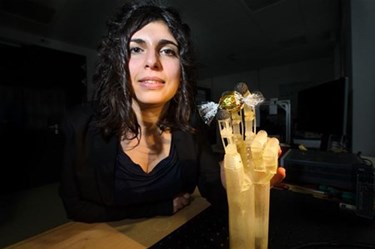New Bionic Hand Uses "Smart Wires" To Mimic Human Muscles

German scientists have introduced a bionic hand with muscles made from bundles of hair-thin “smart wires.” Though the technology is still in its prototype phase, engineers hope to develop their design into prosthetics that are lighter, less cumbersome, and more “natural.”
Their secret is the “shape-memory” wires made from nickel-titanium alloy — or nitinol — which is being investigated by a number of different device developers because of its biocompatibility and non-corrosive properties.
These wires, when bundled together, can tense up when a small electrical charge is applied, and then “relax” into their original shape once the charge is taken away. Scientists told Reuters that the unique properties of the wires, and their bundling, allow for highly precise movements because of their exceptionally high energy density.
Filomena Simone, a PhD student who co-developed the prototype, explained to Reuters that the bundling gives the hand a larger surface area, and because heat can dissipate faster, the hand can express a number of different movements rapidly, just like the muscles in a human hand.
The team of engineers was led by Stefan Seelecke at Saarland University, who said in a press release earlier this year that the design was inspired by the human hand, which he described as the “perfect tool.” Seelecke told Reuters that his team’s prototype is more natural and user-friendly because they’re essentially recreating a system that has been time-tested over the course of human evolution.
Simone added that a single semiconductor chip controlled the shape of the wires by using electrical resistance, and the wire has the necessary properties to perform actions that usually require external sensors. By stripping away the need for bulky electronics, Simone says that the prototype is extremely lightweight, a significant advantage over existing bionic hand prototypes, which often require a lot of external equipment.
The newest innovations in bionic hand prosthetics seek to create lightweight equipment that is easy to use, working as naturally during day-to-day activities as an actual human hand. Some prototypes and marketable models can communicate directly with the user’s nervous system to activate the hand and drive movement.
Developers of a bionic hand at the University of Newcastle are working on a two-way communication system, in which the user’s brain can communicate with the hand and the hand can communicate back, allowing the user to experience natural tactile sensations.
Nervous system integration, according to Seelecke, is the future of prosthetics, and his team’s next step will be to integrate their prototype into a model that can sense nerve stimuli.
“So, eventually you need a couple nerves with proper electrodes and combine that with the actuation of muscles so you can create some integrated, biologically inspired actuation system for prostheses,” he said.
